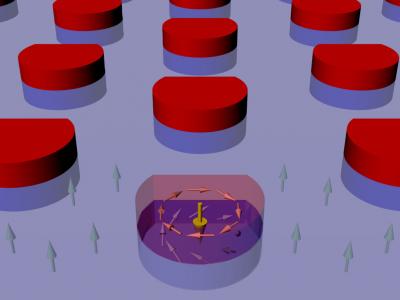A new way to create spintronic magnetic information storage
October 9, 2015

A magnetized cobalt disk (red) placed atop a thin cobalt-palladium film (light purple background) can be made to confer its own ringed configuration of magnetic moments (orange arrows) to the film below, creating a skyrmion in the film (purple arrows). The skyrmion might be usable in computer data storage systems. (credit: Dustin Gilbert / NIST)
Exotic ring-shaped magnetic effects called “skyrmions*” could be the basis for a new type of nonvolatile magnetic computer data storage, replacing current hard-drive technology, according to a team of researchers at the National Institute of Standards and Technology (NIST) and several universities.
Skyrmions have the advantage of operating at magnetic fields that are several orders of magnitude weaker, but have worked at only very low temperatures until now. The research breakthrough was the discovery of a practical way to create and access magnetic skyrmions, and under ambient room-temperature conditions.
The skrymion effect refers to extreme conditions in which certain magnetic materials can develop spots where the magnetic moments** curve and twist, forming a winding, ring-like configuration. To achieve that, the physicists placed arrays of tiny magnetized cobalt disks atop a thin film made of cobalt and palladium. That protects them from outside influence, meaning the data they store would not be corrupted easily.
But “seeing” these skyrmion configurations underneath was a challenge. The team solved that by using neutrons to see through the disk.
That discovery has implications for spintronics (using magnetic spin to store data). “The advantage [with skyrmions] is that you’d need way less power to push them around than any other method proposed for spintronics,” said NIST’s Dustin Gilbert. “What we need to do next is figure out how to make them move around.”
Physicists at the University of California, Davis; University of Maryland, College Park; University of California, Santa Cruz; and Lawrence Berkeley National Laboratory were also involved in the study.
* Named after the physicist who proposed them.
** The force that a magnet can exert on electric currents and the torque that a magnetic field will exert on it.
Abstract of Realization of ground-state artificial skyrmion lattices at room temperature
The topological nature of magnetic skyrmions leads to extraordinary properties that provide new insights into fundamental problems of magnetism and exciting potentials for novel magnetic technologies. Prerequisite are systems exhibiting skyrmion lattices at ambient conditions, which have been elusive so far. Here, we demonstrate the realization of artificial Bloch skyrmion lattices over extended areas in their ground state at room temperature by patterning asymmetric magnetic nanodots with controlled circularity on an underlayer with perpendicular magnetic anisotropy (PMA). Polarity is controlled by a tailored magnetic field sequence and demonstrated in magnetometry measurements. The vortex structure is imprinted from the dots into the interfacial region of the underlayer via suppression of the PMA by a critical ion-irradiation step. The imprinted skyrmion lattices are identified directly with polarized neutron reflectometry and confirmed by magnetoresistance measurements. Our results demonstrate an exciting platform to explore room-temperature ground-state skyrmion lattices.